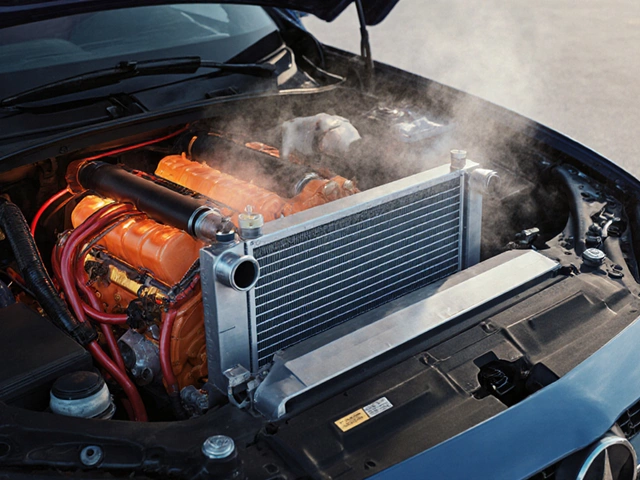The quest for the perfect exhaust sound is a journey that many car enthusiasts embark on with zest. Whether you're seeking the satisfying rumble that turns heads or a refined tone that hints at hidden power, the exhaust system plays a key role in defining your vehicle's character. Understanding the elements that contribute to an exhaust's acoustic signature can transform the driving experience.
Each exhaust system is a symphony of materials, engineering, and design, crafted to produce a specific sound. The choices are as varied as the cars they adorn, from aggressive roars to understated hums. To find the sweet spot where sound and performance meet, it's helpful to know the mechanics behind the noise. Whether driven by the need for speed or the sheer joy of the auditory blast, your choice of exhaust reflects personal style and driving passion.
- The Science of Exhaust Acoustics
- Popular Exhaust System Types
- Sound and Performance: Finding Balance
- Top Exhaust Brands for Sound Quality
The Science of Exhaust Acoustics
The world of exhaust systems is deeply rooted in the rich blend of science and personal preference, a place where physics meets passion. At its core, the sound of an exhaust system is shaped by the pressure waves that form within the pipes, resonators, and mufflers as your engine's gases are expelled. As these gases move, they create vibrations, turning your vehicle into a drum of sorts, with every part of the exhaust contributing to the unique acoustic signature. The journey starts with the engine's pistons, which create gas pulses. How these pulses travel, split, and merge determines the symphony that emerges from your tailpipe.
Engine size and configuration inevitably affect this sound. A throaty V8 produces a different type of wave and pulse pattern than a buzzing four-cylinder does. The length and diameter of the exhaust pipes play significant roles as well. Wider pipes may offer less back-pressure, which can change dynamics entirely, converting sound motives into distinctive chorales of deep resonance or high-pitched notes, depending on engine needs. Pipe bends and their very nature influence reverberation and wave damping, providing either pleasing harmony or discordant racket. Expertly crafted systems leverage these principles to achieve sought-after tunes. This is not merely about mechanics but the subtle art of acoustics.
Describing exhaust sound often borrows from musical vernacular, with descriptors like 'bass,' 'notes,' and 'pitch' featuring prominently. This characterization celebrates the creative dance between math and melody. While selecting an exhaust, the balance between sound and performance becomes crucial. An acoustically tuned system enhances the character of a car without negatively impacting performance. This harmonious synergy is what both auto engineers and enthusiasts strive for. When done right, this blend can elicit an emotional response akin to a composer experiencing a symphony's inaugural performance. It demonstrates that exhaust acoustics is as much an art as it is a science.
"The ideal exhaust system balances sound, aesthetics, and performance—like a fine piece of music. Each component plays its part in conveying power through sound," says renowned auto acoustics engineer Mark Thurston.
Often, different exhaust systems are tailored to cater to drivers who value either subtlety in their daily commute or the visceral roar that accompanies high-performance driving. This is engineered through the careful selection of materials like stainless steel or titanium, which have peculiar sound-damping properties and durability. These metals redistribute vibrations and match them to specific acoustic goals, thereby ensuring consistency in how sound waves are released. Advanced computer simulations now allow engineers to predict and tune exhaust sounds with ever-increasing precision, providing endless options to match a driver's taste. In essence, every decibel and frequency is scrutinized and curated to resonate with the desired auditory aesthetic.

Popular Exhaust System Types
When diving into the world of exhaust systems, the variety can seem overwhelming, but understanding the options available can simplify the decision-making process significantly. One of the most common types is the Catback exhaust system. This setup replaces everything from the catalytic converter back, often enhancing both sound and performance. Catbacks are particularly favored among car enthusiasts for their ability to dramatically improve the exhaust note without breaching emissions regulations. Many drivers report a noticeable difference in vehicle tone and a small uptick in horsepower thanks to reduced backpressure.
Another popular choice is the Axle-back exhaust system. This type focuses on the components from the rear axle towards the end of the vehicle. An Axle-back is typically easier to install than a full Catback system, making it a go-to for those wary of extensive modifications. While it primarily affects sound, it offers a cost-effective way to embolden a car's auditory footprint. Among the top brands offering these systems, Borla and Magnaflow are noted for their distinct acoustic signatures, often described as deep yet smooth.
The third type to consider is the Header-back exhaust system. This setup is the most comprehensive, replacing the entire exhaust system from the headers to the tip. It's often sought by those who are involved in competitive racing or high-performance builds. Because of its all-encompassing range, it provides the most significant changes in sound and power. However, it's important to note that Header-backs may not be legal in all areas due to emission regulations, a factor worth checking before purchasing.
There are those who prefer custom exhaust builds, tailored to their specific desires and vehicle quirks. Custom systems give drivers the flexibility to select specific elements from each type—whether it be a unique resonator or a particular muffler style. Custom builds often involve collaboration with skilled technicians to achieve the exact sound profile desired. As noted by exhaust expert Tim Lovejoy, "A custom exhaust is like a suit made to measure. When done right, it complements the car's persona to perfection."
Tim Lovejoy, renowned performance technician, once said, "The best exhaust systems are those that speak the language of the driver at just the right volume."
Regardless of whether you choose a standardized system or a bespoke creation, each option has its place in the landscape of automotive sound engineering. Choosing between types often comes down to budget, desired sound, and performance boosts. The right exhaust system not only uplifts the driving experience through auditory delight but also through a newfound connection between driver and machine. As the growl or purr resonates in the air, one finds that the journey becomes as thrilling as the destination itself.

Sound and Performance: Finding Balance
Achieving the right balance between sound and performance in an exhaust system is often likened to finding harmony in a well-composed piece of music. For many car enthusiasts, it's not just about making noise, but about creating a melodic sound that complements their vehicle's performance. The exhaust sound is one of the most immediate and visceral ways drivers experience their car, marrying the emotional joy with the functional side of automotive engineering. When considering an upgrade, it is essential to understand that sound and performance are not mutually exclusive; rather, they should enhance each other. A properly tuned exhaust system can reduce back pressure and increase horsepower, resulting in a smoother, more powerful ride.
Exploring Materials and Craftsmanship
Materials such as stainless steel and titanium are commonly used in high-performance exhausts, known for their durability and sound-altering properties. Each material affects sound differently—stainless steel tends to produce a deeper growl while titanium often provides a sharper note. The thickness of the material can also impact the tonality, with thinner walls generally producing a higher pitch. Many high-end exhaust systems incorporate ceramic coatings, which not only add an aesthetic appeal but also enhance heat retention, improving performance by optimizing engine efficiency.The Role of Design in Sound and Power
Design intricacies like equal-length headers, X-pipe configurations, and resonators all contribute significantly to how an exhaust sounds. Equal-length headers, for instance, are praised for their ability to equalize exhaust pulses, resulting in a consistent and harmonious sound. On the other hand, X-pipes merge exhaust streams to create a cleaner, higher-pitched tone, often favored for sporty soundscapes. Resonators work to smooth out inconsistencies, preventing droning and fine-tuning the sound quality.The Influence of Back Pressure
Back pressure is a critical factor to consider when modifying an exhaust system, as it can affect engine performance directly. While a degree of back pressure is necessary for gas scavenging—where exhaust gases are efficiently expelled from the combustion chamber—too much can stifle performance, reducing horsepower and fuel efficiency. Achieving the optimal level of back pressure is crucial, allowing exhaust systems to contribute positively to engine performance and efficiency."Exhaust sound tuning is not just an art, it's a science," remarks David Vizard, a renowned engine builder and author, capturing the balance of precision and creativity that defines the craft of exhaust system design.
The market offers a range of specific setups that promise the dual benefits of sound and performance, but the best choice often relates to personal preference and driving style. Some brands focus on producing a certain 'signature sound' while others might prioritize performance gains. Ultimately, the exhaust systems that provide the best sound are those that strike this desired equilibrium effectively, creating an experience that feels both powerful and satisfying.

Top Exhaust Brands for Sound Quality
When it comes to finding the perfect blend of sound quality and performance, certain exhaust brands have built a reputation for delivering unmatched satisfaction to car enthusiasts. One of the legendary names in the industry is Borla, celebrated for its signature sound and engineering precision. Known for their cat-back and axle-back systems, Borla uses stainless steel and patented technology to provide an aggressive yet melodic tone that many muscle car owners crave. What sets Borla apart is not just the deep, thrilling growl their systems offer, but also the performance boost inherent in their designs, which often translates to noticeable gains in horsepower and torque.
Moving on, we have Akrapovič, a favorite among European car enthusiasts. With roots in the high-adrenaline world of motorsports, Akrapovič exhausts are crafted using lightweight materials like titanium and carbon fiber. This not only enhances the aural pleasure but also reduces the vehicle's weight, thus boosting speed efficiency. Akrapovič systems are known for their distinctive, sharp note that evokes the thrill of a race track. Their dedication to innovation and quality is evident in their attention to the acoustic signature of each system, ensuring that it complements the sophisticated nature of cars like BMW and Audi.
"Our goal is to create an emotional sound experience that compliments the car and driver," says Uroš Rosa, CEO of Akrapovič.
Another brand making waves in the sound quality domain is MagnaFlow. Their focus on sound performance with rigorous testing makes them a go-to choice for those who prefer a deeper, more refined sound. The brand offers a wide range of options, from street-legal systems to race-focused setups, each engineered to provide optimum flow and acoustics. A unique feature is their use of acoustic-absorbing technology, which ensures that the sound remains consistent under various driving conditions. MagnaFlow’s commitment to crafting exhausts known for rich quality puts them at the forefront of sound-focused performance enhancements. Their stainless steel constructions not only amplify the vehicle's growl but also enhance durability, promising drivers a long-lasting product.
For those who favor American muscle, Flowmaster remains a household name. Known for their iconic chambered muffler technology, Flowmaster systems offer an aggressive, throaty roar that is unmistakable on the streets. Their American Thunder series, in particular, is revered for transforming the driving experience with its powerful acoustic presence. Drivers of classic muscle cars often opt for Flowmaster for its authentic sound that pays homage to the golden era of automotive power. A notable aspect of Flowmaster's innovation is their SOX (Sound, Objective, eXperience) project, focused on providing precise sound enhancements tailored to individual preferences.
In the realm of high-performance sports cars, brands like Remus have carved a niche with their meticulously engineered systems. Hailing from Austria, Remus exhausts are developed using advanced CAD technology and feature a signature deep, sporty sound. Their systems often incorporate innovative sound controllers, allowing drivers to customize their exhaust notes on the fly. This adaptability has made them increasingly popular among car aficionados who value personalization and control. Remus couples their sound expertise with a focus on aerodynamics, ensuring that the design of their exhausts not only sounds good but aids in the vehicle's overall driving dynamics.




